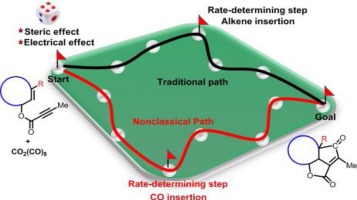132.Theoretical prediction on the reactivity of the Co-mediated intramolecular Pauson-Khand reaction for constructing bicyclo-skeletons in natural products
LeiZhu, ZheyuanWang, SongLiu, TaoZhang, ZhenYang, RuopengBai, YuLan
Chin. Chem. Lett. 2019, 30 (4), 889-894
The Co2(CO)8-mediated intramolecular Pauson-Khand reaction is an efficient approach for constructing polycyclic skeletons. Recently, some of us reported a series of this type reactions involving sterically-hindered enynes for synthesizing natural products with reasonable reaction rates and yields. However, the reason for the high reactivity of the reaction remains unclear. We employed density functional theory calculations to clarify the mechanism and reactivity for this reaction. In contrast with chain olefin reactants, CO insertion is considered to be the rate-determining step for the overall Pauson-Khand reaction of cyclooctene derivatives. The reduced activation free energy for the alkene insertion step is attributed to: i) the electron-withdrawing group in close proximity to the CC triple bond enhancing the reactivity of the alkyne moiety; ii) lower steric hindrance during alkene insertion when using the cyclooctene derivative. The effect of the substituent on the Co2(CO)8-mediated intramolecular Pauson-Khand reaction was then investigated. Internal alkenes exhibit lower reactivity than terminal alkenes because of the steric hindrance introduced by the substituted group. The cis internal alkene exhibits higher reactivity than the trans internal alkene. An ester group in close proximity to the CC triple bond significantly enhances the reactivity.

